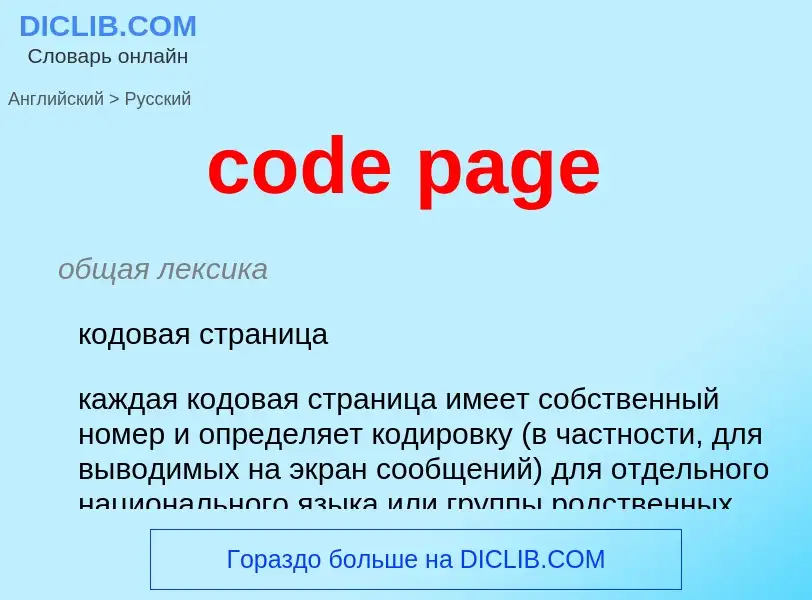Перевод и анализ слов искусственным интеллектом ChatGPT
На этой странице Вы можете получить подробный анализ слова или словосочетания, произведенный с помощью лучшей на сегодняшний день технологии искусственного интеллекта:
- как употребляется слово
- частота употребления
- используется оно чаще в устной или письменной речи
- варианты перевода слова
- примеры употребления (несколько фраз с переводом)
- этимология
code page - перевод на русский
общая лексика
кодовая страница
каждая кодовая страница имеет собственный номер и определяет кодировку (в частности, для выводимых на экран сообщений) для отдельного национального языка или группы родственных языков
синоним
Смотрите также
['peidʒbɔi]
существительное
общая лексика
длинная женская стрижка «под пажа» (типа каре)
длинная женская стрижка 'под пажа'
синоним
Смотрите также
['kɪdɪkrɑ:ft]
общая лексика
"Киддикрафт" (фирменное название пластмассовых и деревянных игрушек компании "Хестэр" [Hestair])
общая лексика
базовая (исходная, начальная, главная) [Web-] страница
название первой страницы сайта, с которой начинается его просмотр в WWW. В общем случае, в любой гипертекстовой системе документ имеет начальную точку входа
синоним
[,peɪdʒ'θri:gə:l]
общая лексика
"девушка с 3-й страницы" (фотография обнажённой красотки)
такие фотографии в течение долгого времени помещались на 3-й странице газеты "Сан" [Sun]
Определение
Википедия
In computing, a code page is a character encoding and as such it is a specific association of a set of printable characters and control characters with unique numbers. Typically each number represents the binary value in a single byte. (In some contexts these terms are used more precisely; see Character encoding § Character sets, character maps and code pages.)
The term "code page" originated from IBM's EBCDIC-based mainframe systems, but Microsoft, SAP, and Oracle Corporation are among the vendors that use this term. The majority of vendors identify their own character sets by a name. In the case when there is a plethora of character sets (like in IBM), identifying character sets through a number is a convenient way to distinguish them. Originally, the code page numbers referred to the page numbers in the IBM standard character set manual, a condition which has not held for a long time. Vendors that use a code page system allocate their own code page number to a character encoding, even if it is better known by another name; for example, UTF-8 has been assigned page numbers 1208 at IBM, 65001 at Microsoft, and 4110 at SAP.
Hewlett-Packard uses a similar concept in its HP-UX operating system and its Printer Command Language (PCL) protocol for printers (either for HP printers or not). The terminology, however, is different: What others call a character set, HP calls a symbol set, and what IBM or Microsoft call a code page, HP calls a symbol set code. HP developed a series of symbol sets, each with an associated symbol set code, to encode both its own character sets and other vendors’ character sets.
The multitude of character sets leads many vendors to recommend Unicode.

![Lord Patten]], robed as [[Chancellor of Oxford University]], assisted by a page. Lord Patten]], robed as [[Chancellor of Oxford University]], assisted by a page.](https://commons.wikimedia.org/wiki/Special:FilePath/Chris Patten.jpg?width=200)

![''The Queen and the Page'', by [[Marianne Stokes]], 1896. ''The Queen and the Page'', by [[Marianne Stokes]], 1896.](https://commons.wikimedia.org/wiki/Special:FilePath/Marianne Stokes - The Queen and the Page.jpg?width=200)
![Alof de Wignacourt and his page]]'', by [[Caravaggio]], c. 1608. Alof de Wignacourt and his page]]'', by [[Caravaggio]], c. 1608.](https://commons.wikimedia.org/wiki/Special:FilePath/Portrait of Alof de Wignacourt and his Page-Caravaggio (1607-1608).jpg?width=200)







![A portion of the "[[Zimmermann Telegram]]" as decrypted by [[British Naval Intelligence]] codebreakers. The word ''Arizona'' was not in the German codebook and had therefore to be split into phonetic syllables. A portion of the "[[Zimmermann Telegram]]" as decrypted by [[British Naval Intelligence]] codebreakers. The word ''Arizona'' was not in the German codebook and had therefore to be split into phonetic syllables.](https://commons.wikimedia.org/wiki/Special:FilePath/Ztel2.jpg?width=200)


![An intentionally blank page on a PDF document from the [[Australian Electoral Commission]]. The document has 80 printable pages, and content ends on page 77. An intentionally blank page on a PDF document from the [[Australian Electoral Commission]]. The document has 80 printable pages, and content ends on page 77.](https://commons.wikimedia.org/wiki/Special:FilePath/AEC blank page.png?width=200)
